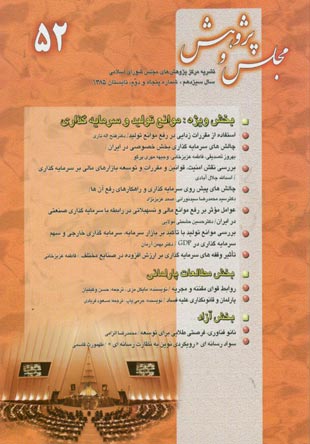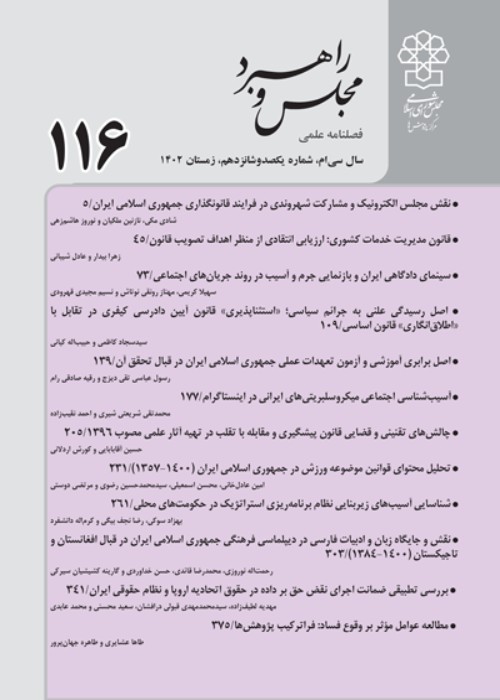فهرست مطالب

فصلنامه مجلس و راهبرد
پیاپی 52 (بهار و تابستان 1385)
- 345 صفحه، بهای روی جلد: 10,000ريال
- تاریخ انتشار: 1385/02/12
- تعداد عناوین: 12
-
صفحه 5
- بخش ویژه: موانع تولید و سرمایه گذاری
- بخش مطالعات پارلمانی
-
صفحه 199
-
صفحه 217
- بخش آزاد
-
صفحه 245
-
Page 11Restrictive obstacles in various economic and social sectors are considered as a problem in growth and development of countries. Hence, deregulation is one of methods which have been important as a factor for removing barriers of economic development since recent decades.Deregulation may be implemented in such different sectors as administrative, management, executive, legal, and economic ones, but its main goal is to remove different barriers. Researches show that such countries as China have been able to have high growth rate by using deregulation. The five-year plans in Iran have considered deregulation as a policy for removing production obstacles. A look at the different five-year plans shows that there are many parts in which deregulation are considered. But that to what extent the different parts of the plans have been implemented is one important ambiguity in this regard. For example, the reliable data about the benefit obtained by getting out of garrisons as well as state organizations from urban areas are not available. Also, some articles of the plans have been repeatedly mentioned in the next plans, while they should be articulated in other distinct and complete laws if it was necessary to do so.Keywords: deregulation, five, year plans, monopoly, market failure
-
Page 31While referring to various studies on the obstacles of investment and reviewing the trend of private and public investment in Iran, this paper tries to explain the factor affecting on private investment,including public investment as an infrastructure of private investment. Multiplicity of regulation, inflexibility, and high rate of risk are recognized as some obstacle for extension of private investment in Iran. This paper finally poses some solutions in order to encourage private investment as well as to remove its obstacles.Keywords: private sector investment, public sector investment
-
Page 55Economic literature considers investment as an important factor in the growth and development of countries. In addition to the amount of investment, its quality and efficiency play a significant role as well. A look at the economic trends in Iranian economy shows that the investment trend has been full of ups and downs since the 1979 Islamic Revolution, so that the amount of investment in 2001 (at constant 1980 prices) was hardly equal to its amount in 1979. There are some reasons in this regard. Instability and insecurity of investment, a restrictive set of complex rules and regulation,warrants and other institutional disturbances, and underdevelopment of financial markets are among factors leading to the low amount of investment in Iranian economy. According to official international data, Iran has not a good rate as far as risk easuring indexes are concerned. Thus, the investors have insufficient motive for investing in Iranian economy.Keywords: investment, risk, yield, capital market, security, moral hazard
-
Page 91This paper studies how to remove productions restrictions with emphasizing on investment. In doing so, first of all, the trend of total investment on the part of both private and public sectors is reviewed. At the same time, the situation of capital market (stock exchange) as a part of financial markets is described. Then, obstacles confronting investment both from internal and external aspects such as legal restrictions, risk, and foreign investment are discussed. Finally, some solutions for removing current obstacles in investment process are suggested.Keywords: investment, stock exchange, risk, rate of profit, laws, solutions
-
Page 119In comparison with such other sectors as construction, housing,trade, agriculture, and service, the allocation of banking facilities in industrial sector has faced more difficulties. The main factors for making the banking facilities inefficient in industrial investment have been on the one hand the high interest rate in banking system over recent years, the increase in worker wages and, on the other,the importation of smuggled foreign goods and the complex bureaucracy for providing financial resources in banking system.Thus, it seems that, for eliminating constraints of industrial investment, credit policies must encourage producers and investors in this sector while simultaneously considering other policies in a common office.Keywords: industrial sector facilities, constant return to scale, Cobb
-
Page 145In some countries per capita income is about $40000; while in some other countries there are peoples whose daily incomes are less than $1. The obstacles of production are not the case only with Iran,There are other countries whose per capita income are less than Iran. One can easily involve with non-productive activities in Iran while productive activities which increase domestic production usually face many obstacles. This paper tries to theoretically deal with such problem, empirically taking such cases as capital market, tax laws, and exchange reserve fund into account. Many economic and production laws have been written so many years ago by foreign experts. The world economy has changed substantially over these years, not least in the last two decades. For example, stock market laws should be substantially changed, exchange reserve fund is in a bad situation, or tax laws tend to be against industrial development. Although these policies are imposed on Iran by such international agencies as World Bank and International Monetary Fund, Iranian experts and policy-makers should make many reforms in this regard.Keywords: capital market, foreign investment, investment
-
Page 169Investment is one of the most important factors in progress and development of countries. Since the required investment in various economic sectors or industries is different, some of industries are rapid-return and some of them are slow-return. Therefore, in order to determine which sector or industry should be placed on the development agenda if the decision-maker's goal is to get return more rapidly, it is necessary to have an appraisal from various industrie's lags, as far as investments lags are concerned. By using distributed lag Almon Model, this paper tries to estimate time lags for different sectors in Iranian industries during the 1350-1382 periods. The results show that the textile and clothing, wood product, cardboard and paper, food and drinking, and potpourri industries are rapid-return, while chemical, machine tool, metal, and non-metal mineral industries are slow-return. These results do contribute to decision-making and policy-making towards getting return more rapidly.Keywords: distributed lag model, Koyck Model, Almon Model
-
Page 199Studies of legislatures can be divided in to two broad categories:The internal Variables and the external one Among the external variable Such as the constituents, interest groups, political parties etc, the relationship between Legislatures and Exective is in focal point which has been analysed in this article. Constitutional forms of this relationship, the system of political parties and its impact on the relationship between legislatures and executives, policy expertisc and the different forms of political system such as parliamentary presidential or semi presidential regiems, has been considered in this article.Keywords: Legislatures, Executive, Executive relations, Parliamentary, Presidential, Semi presidential Regiems
-
Page 217Parliament has a critical role to play in fighting corruption, both in eanacting appropriate laws to counter corruption and in seeing, through its committees, that these laws are enforced. To this aim, thay cover tree aspects of corruption: to criminalize and punish diverse corrupt actions as bribery, nepotisim, conflicts of interest and cronyism; to ameliorate an administrative and social environment; and to amend the anti-corruption legislation. Finally, any efficient legal system requires exact, enforceable and "corruption-proofed" laws to deter meaningfully the corruption.Keywords: Parliament, Legislation, Corruption, Anti, Corruption, Criminal Law, Nepotism, Cronyism, Bribery
-
Page 245A nanometer is a unit of spatial measurement that is 10−9 meter, or one billionth of a meter. It is spatial for commonly used in nanotechnology; a scale in which atoms and molecules interact or combine with each other. Nanotechnology and nanoscience include the capacity to control materials even in a nano scale for using physical, chemical and biological properties in nano materials, instrument and to use new systems. As this technology is new and globally spatial, Iran nowadays starts to explore this technology. The main purpose of this article is firstly to introduce and identify nanotechnology and nanotechnology advantages, secondly to study nanotechnology statues in the world. Hereby, for comparing the statues of nanotechnology in Iran with other expert countries in this technology we intend common indicators, showing a new perspective of nanotechnology in Iran and other countries. By general overview on knowledge - based economy planning in Seventh Framework Programme (FP7) was hold in European Community (EC) - we are trying to show a proper sample or a new paradigm usage in high level of technology. And finally by expressing its opportunities and threats as well as its weak and rise points to approach nanotechnology problems in order to achieve quick development in this technology, we can interest in it in future.Keywords: nanotechnology, Nano, knowledge, based economy, indicators, investment
-
Page 307Media literacy is the ability of accessing, analyzing, critical evaluating and creating messages in a wide variety of forms. Not only it determines the ownership, property, motivation, and implicit values in messages but it regulates also a consuming regime for media audiences. Media literacy contains four spheres of cognitive, intuitive, ethical, and aesthetic, which interact with each other.Indeed, media literacy is a science which helps to social control system in the today world and can be effective in reducing the costs of ternate forces, because it provides tools to help consumers critically analyze messages. Thereby media literacy can reduce the bad effects of media, helping to change parliament's approach from maximal to minimal legislative.Keywords: media literacy, addressee, control


